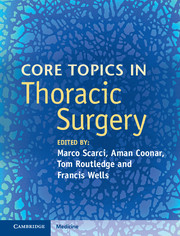Book contents
- Frontmatter
- Contents
- List of contributors
- Section I Diagnostic work-up of the thoracic surgery patient
- Section II Upper airway
- Section III Benign conditions of the lung
- Section IV Malignant conditions of the lung
- 11 Evaluation of solitary pulmonary nodule
- 12 Lung cancer staging
- 13 Pathological considerations in lung malignancy
- 14 Medical treatment of lung cancer (neo and adjuvant chemoradiotherapy)
- 15 Superior vena cava obstruction: etiology, clinical presentation and principles of treatment
- 16 Robotics in thoracic surgery
- 17 Pulmonary metastasectomy
- Section V Diseases of the pleura
- Section VI Diseases of the chest wall and diaphragm
- Section VII Disorders of the esophagus
- Section VIII Other topics
- Index
- References
13 - Pathological considerations in lung malignancy
from Section IV - Malignant conditions of the lung
Published online by Cambridge University Press: 05 September 2016
- Frontmatter
- Contents
- List of contributors
- Section I Diagnostic work-up of the thoracic surgery patient
- Section II Upper airway
- Section III Benign conditions of the lung
- Section IV Malignant conditions of the lung
- 11 Evaluation of solitary pulmonary nodule
- 12 Lung cancer staging
- 13 Pathological considerations in lung malignancy
- 14 Medical treatment of lung cancer (neo and adjuvant chemoradiotherapy)
- 15 Superior vena cava obstruction: etiology, clinical presentation and principles of treatment
- 16 Robotics in thoracic surgery
- 17 Pulmonary metastasectomy
- Section V Diseases of the pleura
- Section VI Diseases of the chest wall and diaphragm
- Section VII Disorders of the esophagus
- Section VIII Other topics
- Index
- References
Summary
Introduction
The great majority of primary malignant lung tumours are carcinomas derived predominantly from the epithelium of bronchi, bronchioles and alveoli. These neoplasms are divided, mainly on the basis of histopathological features, into four cell types: small cell carcinoma, squamous cell carcinoma, adenocarcinoma and large cell carcinoma; the latter three cell types grouped together represent non-small cell carcinomas. In recent years, it has become increasingly important to subclassify non-small cell carcinomas even in small biopsy specimens in view of therapeutic advances and the development of targeted therapies, such as tyrosine kinase inhibitors for tumours with EGFR mutations or EML4-ALK translocations, mainly seen in adenocarcinomas. Some chemotherapeutic agents, such as pemetrexed, for example, are also more efficacious in adenocarcinomas.
Small cell carcinoma is an aggressive neuroendocrine tumour, often presenting at an advanced stage. Neuroendocrine tumours of the lung are a distinct subset of tumours which share morphological, ultrastructural and immunohistochemical characteristics. In addition to small cell carcinoma, the other morphologically identifiable neuroendocrine tumours of the lung are large cell neuroendocrine carcinomas and typical and atypical carcinoid tumours.
It should be noted that lung carcinomas may be mixed and composed of more than one cell type. Sarcomatoid carcinomas comprise approximately 0.3% of lung malignancies, and this group of poorly differentiated lung carcinomas expresses a spectrum of pleomorphic, sarcomatoid and sarcomatous elements.
Rarely, malignant salivary gland type tumours, mainly adenoid cystic carcinomas or mucoepidermoid tumours, arise from the mixed seromucous glands of the trachea and bronchi, as these are similar to the minor salivary glands and can therefore give rise to the same range of tumours.
Primary malignant neurogenic, vascular and mesenchymal tumours can also occur within the lungs and the morphological features of these types of tumours reflect those seen in extrapulmonary lesions.
Whilst the lungs are often involved in disseminated nodal lymphomas of all types, primary pulmonary lymphoma is relatively rare, accounting for less than 0.5% all of primary lung neoplasms.
It should also be remembered that the lungs are a very common site for metastatic disease, most commonly due to haematogenous or lymphatic spread of extrapulmonary tumours. Dissemination within pulmonary lymphatics may be widespread, producing the appearances of so-called lymphangitis carcinomatosa.
- Type
- Chapter
- Information
- Core Topics in Thoracic Surgery , pp. 127 - 139Publisher: Cambridge University PressPrint publication year: 2016

